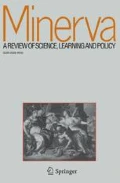Conclusions
An interest in economic development has been extended to a set of research universities which since the late nineteenth century had been established, or had transformed themselves, to focus upon discipline-based fundamental investigations.21 The land-grant model was reformulated, from agricultural research and extension, to entrepreneurial transfers of science-based industrial technology by faculty members and university administrators.
The norms of science, a set of values and incentives for proper institutional conduct,22 have been revised as an unintended consequence of the second revolution. This has happened through an accretion of gradual organisational changes that often go unnoticed, and through conflict that disrupts the status quo and makes change evident. The two forms of normative change became apparent in the emergence of group research and in controversies over conflicts of interest. With extensive financial support from government, large research groups began to replace the traditional form of professor and graduate student—still commonplace in the humanities—as the typical way of organising research, although group leaders were called “individual investigators”.23 Possessing many of the characteristics of a small business, apart from the profit motive, some of these research groups or “quasi firms” are only a short step away from turning into companies when the opportunity arises.
Disputes about conflicts of interest are a step towards the transformation of norms. How they are resolved suggests the shape of the new norm; their continuation indicates that the outcome is still in question; their intensification increases the likelihood that a practice will be defined as deviant. Some conflicts of interest will be resolveable as norms change; others will be defined as fraud and be dealt with by the legal system. Conflicts of commitment may also be amenable to resolution, for example, by granting leave to establish a company. Integrating campus and company research reduces some of the potential for conflict, especially when the university holds the intellectual property rights in question.
Under these new normative conditions what is left of the idea of the university as a source of disinterested expertise? As molecular biology departments have developed a complex network of industrial ties a new critical discipline of environmental science has grown up in academia. Universities are flexible institutions, capable of reconciling many diverse missions.
Similar content being viewed by others
References
Koshland, Daniel, “Conflict of Interest”, Science, CCXLIX, 109 (13 July, 1990).
Knight, Frank, “Some Comments on the Assumption Underlying the Conflict of Interest Concept”, University of Chicago Law School Conference on Conflict of Interest, 1961.
McGuire, Joseph M., “Conflict of Interest: Whose Interest? and What Conflict?”, in De, George, Richard T. and Pilcher, Joseph A. (eds), Ethics, Free Enterprise, and Public Policy (New York: Oxford University Press, 1978); Margolis, Joseph, “Conflict of Interest and Conflicting Interests”, in Beauchamp, Tom L. and Bowie, Norman E. (eds), Ethical Theory and Business (Englewood Cliffs: Prentice-Hall, 1979); Luebke, Neil, “Conflict of Interest as a Moral Category”, Business and Professional Ethics Journal, VI, 1 (1987), pp. 66–81; Lichtenberg, Judith, “Truth, Neutrality and Conflict of Interest”, ibid., IX, 1–2 (1990), pp. 65–78.
Manning, Bayless, Federal Conflict of Interest Law (Cambridge, Mass.: Harvard University Press, 1964).
NIH and ADAMHA Administration, “Request for Comment on Proposed Guidelines for Policies on Conflict of Interest”, NIH Guide for Grants and Contracts, XVIII, 32 (15 September, 1989).
Genuth, Joel, “Groping Towards Science Policy in the United States in the 1930s”, Minerva, XXV (Autumn 1987), pp. 238–269.
Etzkowitz, Henry and Peters, Lois, “Profiting from Knowledge: Organisational Innovations and the Evolution of Academic Norms”, Minerva, XXIX (Summer 1991), pp. 133–166.
Interview with Professor Angela Ulla, director of COPPETEC, 22 May, 1995.
Lanier, Ann and Neuschatz, Michael, “Report to the National Science Foundation”, 1985.
Jordan, David Starr, “To What Extent Should the University Investigator be Relieved From Teaching?”, AAU Journal, XXX (1896), pp. 34–42.
Etzkowitz, Henry, “Knowledge as Property: The Massachusetts Institute of Technology and the Debate Over Academic Patent Policy”, Minerva, XXXII (Winter 1994), pp. 383–421.
Samuelson, Pamela, “Innovation and Competition: Conflicts over Intellectual Property Rights in New Technologies”, Science, Technology and Human Values, XI (1987), pp. 6–21.
Reams, Bernard, University-Industry Research Partnerships (Westport: Quorum Books, 1986).
Livingstone, Angus, “Academic-Industry Workshop”, University of British Columbia, February 1994.
Etzkowitz, Henry, “Redesigning Solomon's House: The University and the Internationalization of Science and Business”, Sociology of Science Yearbook (Dordrecht: Kluwer, 1992).
Group on Scientific and University Research, University-Industry Relations in Perspective (Paris: OECD, 1990).
Bush, Vannevar, Science: The Endless Frontier (Washington, DC: Office of Scientific Research and Development, 1945).
Etzkowitz, Henry, “Beyond the Frontier: The Convergence of Military and Civilian R&D in the U.S.”, Science Studies (December 1994).
National Academy of Sciences, University-Industry Roundtable, “The Cost of Research: Examining Research Patterns and Expenditures Across Sectors”, 1996.
Merton, Robert K., “The Norms of Science”, Journal of Legal and Political Sociology, I (1942), pp. 115–126; reprinted 1973.
Jencks, Christopher and Riesman, David, The Academic Revolution (New York: Doubleday, 1968).
Merton, R.K., “The Norms of Science”, op. cit.
See Etzkowitz, Henry, “Individual Investigators and Their Research Groups”, Minerva, XXX (Spring 1992), pp. 28–50.
Additional information
Note: This article draws on data from a series of studies the author has conducted of academic-industry relations from the early 1980s, supported by the United States National Science Foundation, and recently extended internationally with the assistance of the Andrew Mellon Foundation.
Rights and permissions
About this article
Cite this article
Etzkowitz, H. Conflicts of Interest and commitment in academic science in the United States. Minerva 34, 259–277 (1996). https://doi.org/10.1007/BF00120327
Issue Date:
DOI: https://doi.org/10.1007/BF00120327




